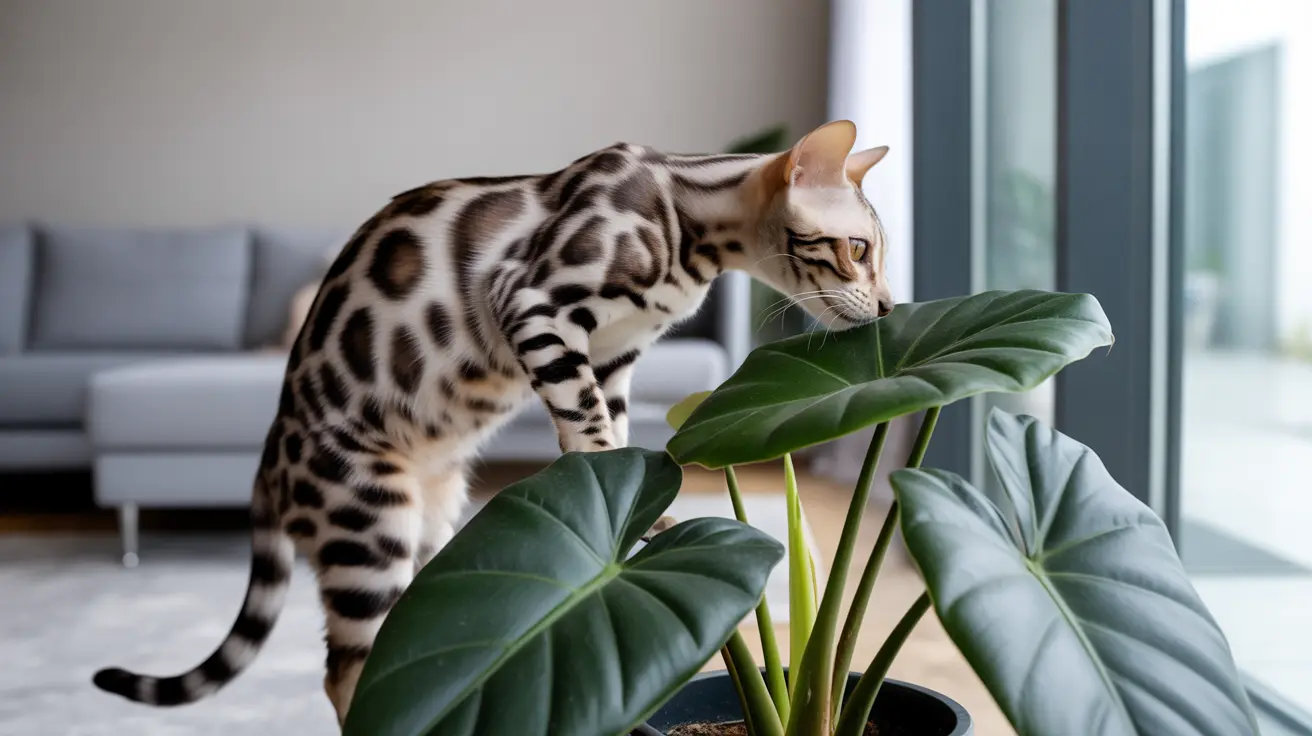Introduction
For cat owners who love houseplants, understanding which species pose risks to their feline friends is crucial. Alocasia, commonly known as Elephant Ear, is a stunning tropical plant that has gained popularity in home decor. However, this beautiful plant harbors a dangerous secret - it's highly toxic to cats.
This comprehensive guide will explore why Alocasia is dangerous to cats, what happens if your cat encounters this plant, and how to keep your feline companion safe. Whether you're a current Alocasia owner or considering adding one to your home, this information could be vital for your cat's wellbeing.
Understanding Alocasia's Toxicity
Alocasia contains insoluble calcium oxalate crystals, known as raphides, throughout its entire structure. These microscopic, needle-like crystals are the plant's primary defense mechanism and can cause immediate and severe reactions in cats who bite, chew, or even brush against the plant.
Every part of the Alocasia plant is toxic - from its dramatic leaves to its stems, roots, and even the sap. This makes it particularly dangerous in households with curious cats who might be attracted to its large, striking foliage.
Signs of Alocasia Poisoning in Cats
When a cat encounters Alocasia, symptoms typically appear rapidly and can include:
- Immediate oral irritation and burning
- Excessive drooling or foaming at the mouth
- Swelling of the tongue, lips, and throat
- Difficulty swallowing
- Vomiting and gastrointestinal distress
- Pawing at the mouth
- Vocal changes or difficulty meowing
In severe cases, cats may experience more serious symptoms such as difficulty breathing, kidney problems, or even cardiac issues. While fatalities are rare, prompt veterinary attention is essential if you suspect your cat has ingested any part of an Alocasia plant.
Emergency Response and Treatment
If you suspect your cat has come into contact with Alocasia, immediate action is crucial:
- Remove any visible plant material from your cat's mouth
- Rinse their mouth with water if possible
- Contact your veterinarian or pet poison control immediately
- Monitor your cat's breathing and overall condition
- Bring a sample of the plant to the vet if possible
Veterinary treatment typically includes supportive care such as IV fluids, anti-inflammatory medications, and pain management. The severity of symptoms usually determines the extent of necessary medical intervention.
Prevention and Safe Alternatives
The best way to protect your cat from Alocasia toxicity is through prevention:
- Remove all Alocasia plants from your home or ensure they're completely inaccessible to cats
- Consider pet-safe alternatives like spider plants, Boston ferns, or African violets
- Create dedicated plant rooms that remain closed to pets
- Educate household members and visitors about the dangers of this plant
- Keep emergency contact numbers readily available
Frequently Asked Questions
How toxic is Alocasia (Elephant Ear) to cats if they chew or ingest it?
Alocasia is highly toxic to cats due to its calcium oxalate crystals. Even small amounts can cause immediate pain, swelling, and respiratory distress. While rarely fatal, it can cause severe discomfort and requires immediate veterinary attention.
What are the common signs and symptoms of Alocasia poisoning in cats?
Common symptoms include immediate oral pain, excessive drooling, swelling of the mouth and throat, vomiting, difficulty swallowing, and pawing at the mouth. In severe cases, breathing difficulties and more serious complications may occur.
What should I do immediately if my cat eats part of an Alocasia plant?
Remove any visible plant material from your cat's mouth, rinse with water if possible, and contact your veterinarian immediately. Bring a sample of the plant for identification and monitor your cat's breathing and overall condition while seeking medical attention.
How can I safely prevent my cat from being exposed to Alocasia toxicity at home?
Remove all Alocasia plants from your home or keep them in completely cat-proof areas. Consider pet-safe alternatives and educate all household members about the risks. Create physical barriers between cats and any toxic plants.
Are there any other common houseplants similar to Alocasia that are also dangerous for cats?
Yes, several common houseplants in the same family (Araceae) are toxic to cats, including Philodendron, Pothos, Peace Lily, and Dieffenbachia. All contain similar calcium oxalate crystals and should be kept away from cats.
Conclusion
While Alocasia's striking appearance makes it a desirable houseplant, the risks it poses to cats cannot be ignored. Understanding these dangers and taking appropriate precautions is essential for any cat owner. If you choose to keep Alocasia in your home, ensuring it's completely inaccessible to your feline companions is crucial for their safety and your peace of mind.






